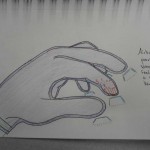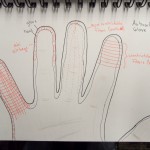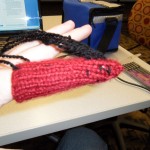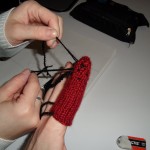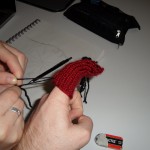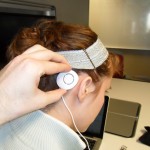View my new prototype of this concept here
The Problem
Texting, composing an email, and taking typed notes should not always require a screen. Even moderately skilled typists can type without looking at the keyboard or at a screen. The problem I attempted to tackle is the problem of needing to type when a screen or keyboard would get in the way. While completely valid in certain situations, text to speech technology can not be used in every situation, so I focused mostly on situations where that technology would also be inhibitive.
Examples of when this is the case:
- Texting, composing an email, or taking notes while walking. The screen is not the focus; where you are going should be the focus. Text to speech could be used here in some situations, but if you’re composing a message containing sensitive information then text to speech would not be ideal.
- While taking notes during an interview in a situation when audio recording would be difficult and a laptop would close you off too much from your interviewee.
- During a meeting or in class when you should be paying attention but feel that your time could be spent participating in a more personally fruitful endeavor.
The New Design
This new design allows users to type when they are in situations in which they can not use a screen or a computer keyboard. The “airboard gloves” provide the user with the same force feedback that a real computer keyboard would. It functions through a series of synthetic, constrictable fibers (much like synthetic muscle fibers). It also uses tiny air bags that can be filled to simulate pressure, similar to the TeleTact Glove developed by the University of Salford [1].
The glove provides the user with four levels of feedback.
- The user can feel the home row bumps on ‘f’ and ‘j.’ This feedback is provided by constrictive fibers that run horizontally.
- The user can feel the keys of the keyboard as he or she moves his or her fingers across the air-keys. This feedback provided by the same fibers that provide the bump feedback.
- The air-key gives resistance when pressed. This feedback is provided by constrictive fibers that run vertically, along the finger.
- The user can feel his or her fingers resting on a key. This feedback is provided by the small airbags that inflate within the glove to simulate pressure.
The New Experience
To turn on the gloves, the user must spin the wristband to the “on” position, and then place their hands in the home row position and hold their hands there for a second. The user will know when he or she can type because they will feel the home row markers of the ‘f’ and ‘j’ key.
As the user moves his or her fingers through the air, the glove provides them the same feedback that they would get from using a keyboard. If they move their hands across the keyboard, they will feel the keys move under their fingers. When they press on a key, they will feel it depress, and will reach a point of total resistance, indicating to them that the key is fully depressed.
The main issue that needs to be addressed is: how do the users review what they’ve typed? A screen is out of the question, because the situations in which these gloves are used require a more subtle solution. Instead, we can use speech to text technology and a hidden speaker. A possible solution is to use similar technology to the implanted cell phone / tooth project [2]. Instead of a tooth, though, it would be less invasive to use something external, but still able to send vibrations through the skull to the user’s eardrums. A plausible solution would be to attach something similar to Merkury’s vibration speaker to the user.
Documents
Airboard Gloves Experience Critique
Attributions
Everything on this page is pulled from the document provided in the documents section. That document was submitted as a project for Erik Stolterman’s Experience Design class for Indiana University Bloomington’s HCI/d program. (This was an individual project.)
[1] M. Benali-Khoudja, M. Hafez, J.-M. Alexandre and A. Kheddar, Tactile interfaces: a state-of-the-art survey, International Symposium on Robotics (2004).
